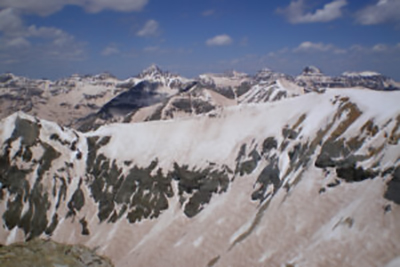Major dust-up for water in the Colorado River
The Colorado River system is the lifeblood of the Southwest, delivering water to 40 million people across the United States and Mexico. Drought and overuse have left the river in crisis—the need for water far exceeds what’s available.
 Nearly all water in the 1,450-mile-long river originates from snowmelt in the Upper
Colorado River Basin, a region adjacent to arid landscapes that regularly blow dust
onto mountain snowpacks. The darker snow absorbs more sunlight, speeds up melting
and depletes snowpacks earlier, leaving downstream communities at risk of running
dry.
Nearly all water in the 1,450-mile-long river originates from snowmelt in the Upper
Colorado River Basin, a region adjacent to arid landscapes that regularly blow dust
onto mountain snowpacks. The darker snow absorbs more sunlight, speeds up melting
and depletes snowpacks earlier, leaving downstream communities at risk of running
dry.
Currently no snowmelt models account for dust, a big problem for water managers who rely on accurate estimates to responsibly allocate water flowing through their districts.
A University of Utah-led study debuts a powerful remote-sensing dataset that informs the timing and magnitude of snow darkening and the impacts on melt rates across the Colorado Basin, in real time. The research is the first to capture how dust effects the broad expanse of headwaters feeding the Colorado River system.
The authors analyzed 23 years of daily satellite images to observe patterns of snow darkened by dust deposition during the melt season during April and May from 2001-2023. The findings revealed that dust-driven melting tends to peak earliest and be most intense in the central-southern Rocky Mountains at mid-alpine elevations.
Across the board, dust accelerated snowmelt every spring, even in less dusty years. Spring melt rates, measured at observation sites, are typically around 10-15 mm per day. The new study found that dust deposition can speed snowmelt by up to 1 mm water-equivalent per hour when the sun is at its peak. In high-dust years, that adds up to 10 mm of melt per day that can be directly attributed to the darkening effect.
“It’s not just how much dust gets deposited over a season, but also the timing of dust deposition that matters,” said Patrick Naple, doctoral candidate of geography at the U and lead author of the study. “Dust is very effective at speeding up melt because it’s most frequently deposited in the spring, when days are getting longer and the sun more intense. Even an extra millimeter per hour can make the snowpack disappear several weeks earlier than without dust deposition.”
As the most comprehensive evaluation of dust-driven snowmelt to date, the study’s insights could help produce a more accurate understanding of dust on snow impacts across the full basin, as well as improve forecasting and water allocation for a system under extreme pressure from changing climate and populations.
“The degree of darkening caused by dust has been related to water forecasting errors. The water comes earlier than expected, and this can have real world impacts—for example if the ground is still frozen it’s too early for farmers to use. A reservoir manager can store early snowmelt, but they need the information to plan for that,” said McKenzie Skiles, associate professor at the U’s School of Environment, Society & Sustainability and the study’s co-lead author. “If we can start to build dust into the snowmelt forecast models, it will make water management decision-making more informed.”
The study was published in Geophysical Research Letters on March 9, 2025.
About the Blog
Discussion channel for insightful chat about our events, news, and activities.
